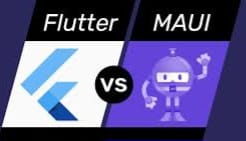Cross-platform app development is on the rise, as businesses seek to reach customers across multiple devices and platforms without having to build separate apps for each one. Two popular cross-platform frameworks are Flutter and .NET MAUI, both of which offer powerful tools for building high-quality, responsive apps that work seamlessly on both iOS and Android devices. In this blog post, we’ll explore the similarities and differences between these two frameworks, and help you decide which one is right for your next app development project.
Flutter: The Leading Choice for Mobile App Development
Flutter is a popular open-source mobile app development framework developed by Google. It is designed to help developers build high-performance, responsive apps for both iOS and Android devices using a single codebase. Flutter uses the Dart programming language, which is fast, efficient, and easy to learn.
One of the key advantages of Flutter is its widget-based architecture, which allows developers to build custom UI elements and animations with ease. Flutter also comes with a rich set of pre-built widgets, making it easy to create complex user interfaces that look and feel great on any device. Additionally, Flutter’s “hot reload” feature allows developers to quickly test and iterate on their code, speeding up the development process.
.NET MAUI: The Future of Cross-Platform App Development
.NET MAUI (Multi-platform App UI) is an upcoming cross-platform app development framework from Microsoft. It is the successor to Xamarin.Forms, which has been a popular choice for building cross-platform mobile apps for several years. .NET MAUI builds on Xamarin.Forms’ strengths while offering new features and capabilities that make it a powerful choice for modern app development.
One of the key advantages of .NET MAUI is its ability to leverage the full power of .NET and C# to build native apps that run on iOS, Android, and Windows devices. This means that developers can take advantage of the rich set of libraries and tools available in the .NET ecosystem, making it easier to build complex apps with advanced functionality. Additionally, .NET MAUI comes with a powerful set of UI controls and templates, making it easy to build responsive and visually appealing apps.
Comparison: Flutter vs .NET MAUI
Both Flutter and .NET MAUI offer powerful tools for building cross-platform apps, but there are some key differences to consider when choosing between them. Here are a few factors to consider:
Programming Language: Flutter uses the Dart programming language, while .NET MAUI uses C#. If you’re already familiar with one language or the other, this may be a factor in your decision.
Development Environment: Flutter uses its own integrated development environment (IDE), while .NET MAUI can be developed using Visual Studio, Visual Studio Code, or JetBrains Rider.
UI Controls: Both frameworks offer a rich set of pre-built UI controls, but .NET MAUI’s controls are more extensive and customizable.
Platform Support: Flutter supports iOS and Android devices, as well as web and desktop applications, while .NET MAUI supports iOS, Android, and Windows devices.
Conclusion
Both Flutter and .NET MAUI are powerful cross-platform frameworks that offer a range of tools and capabilities for building high-quality, responsive apps. Ultimately, the choice between these two frameworks will depend on your specific needs and preferences, including the programming language you’re most comfortable with, the development environment you prefer, and the platform support you require. Regardless of which framework you choose, investing in cross-platform app development can help you reach a wider audience and improve your app’s performance and functionality.

